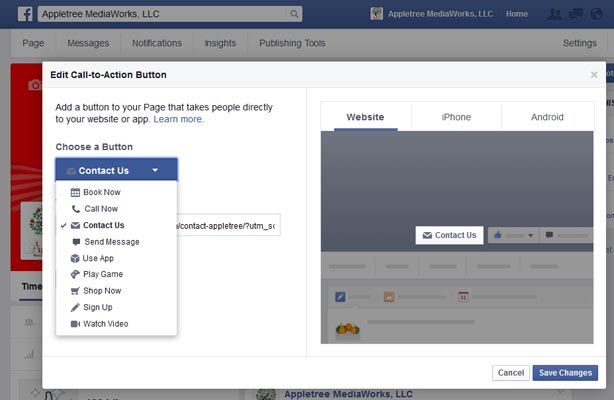How the Internet Helps in a Crisis
Everyone has heard about the recent Paris Attacks on November 13th. Many people have found that the Internet helps in a crisis. The Internet can help to coordinate relief efforts while providing essential communication services to the unfortunate individuals involved in a disaster.
Google Crisis
![]() Google has created some powerful tools to help save the day in times of crisis.
Google has created some powerful tools to help save the day in times of crisis.
Crisis Response – Because Google’s crisis response team analyzes each crisis, each response may be slightly different.
A specific response may include:
- Creating a Resource Page – This is a simple web page containing the most relevant emergency information and tools available for a given crisis.
- Launching Google Person Finder – This is an application which connects friends and loved ones following a disaster. This is useful when there is a large number of missing people and traditional communication lines are unavailable.
- How it works: Google’s Person Finder page lists current disasters. Click on a disaster and you can then choose from either “I’m looking for someone” or “I have information about someone”.

- How it works: Google’s Person Finder page lists current disasters. Click on a disaster and you can then choose from either “I’m looking for someone” or “I have information about someone”.
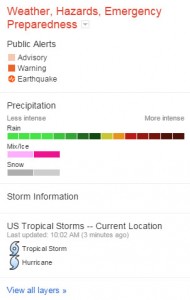 Hosting a Crisis Map – This is a map that displays information concerning the disaster such as storm paths, flood zones, evacuation routes, shelter locations, and power outages. This includes official content and user-generated content.
Hosting a Crisis Map – This is a map that displays information concerning the disaster such as storm paths, flood zones, evacuation routes, shelter locations, and power outages. This includes official content and user-generated content.
Tools For Responders – Do you think your organization may be able to help in a disaster? Google also provides some tools for responders.
- Google Public Alerts – An organization can send emergency alerts if they are relevant to an ongoing crisis. These alerts will appear on Google’s search results, maps, and android devices (using Google Now).
- Person Finder – This can be embedded into your company’s website.
- Crisis Map – This can be embedded in your company’s website.
- Other Google Tools – Docs, spreadsheets, and Earth are all useful tools for responders.
Facebook Safety Check Tool
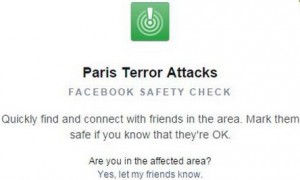 The Facebook Safety Check Tool was originally created for natural disasters. After the Paris Attacks, it has opened up to man made disasters as well. Basically, the Safety Check tool notifies friends and loved ones that you’re safe during a disaster.
The Facebook Safety Check Tool was originally created for natural disasters. After the Paris Attacks, it has opened up to man made disasters as well. Basically, the Safety Check tool notifies friends and loved ones that you’re safe during a disaster.
This was original inspired by the 2011 Tohoku earthquake and tsunami and was then released on October 15th, 2014.
How It Works:
- Affected Area Notification – Facebook sends you a notification if you are in an affected area and asks if you are safe.
- “I’m Safe” –
 After receiving the notification, if you click or tap “I’m Safe” it adds a green “I’m Safe” box next to your name so others can see your status. Other friends may also confirm whether or not you are safe.
After receiving the notification, if you click or tap “I’m Safe” it adds a green “I’m Safe” box next to your name so others can see your status. Other friends may also confirm whether or not you are safe. - Safe Friends Notification – After the tool has been activated you will then receive notifications when your friends have marked themselves as safe.
 Ways Facebook responded to Paris Attacks:
Ways Facebook responded to Paris Attacks:
- Enabled their safety check
- Created a profile picture filter of blue, white, and red
Twitter Alerts
 What? This is an alert that contains vital real-time information during a fast moving emergency. Since this feature is intended for crisis, disaster, and emergency communications, these alerts consist of:
What? This is an alert that contains vital real-time information during a fast moving emergency. Since this feature is intended for crisis, disaster, and emergency communications, these alerts consist of:
- Warnings of imminent dangers
- Preventive instructions
- Evacuation directions
- Urgent safety alerts
- Information on access to essential resources
- Information on critical transit and utility outages
- Crowd and misinformation management.
- Who? Only these groups are authorized to send an alert:
- Law enforcement
- Public safety agencies
- Emergency management agencies
- City and municipal governments
- County and regional agencies
- Select state, federal, and nation agencies and NGOs
- When? Twitter Alerts are used when traditional ways of communication are not available. Such emergencies may include:
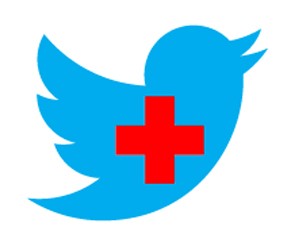 Natural disasters
Natural disasters- Severe weather
- Biological incidents
- Chemical or hazardous materials emergencies
- Nuclear
- Radiological incidents
- Explosions
- Food and agricultural incidents
- Cyber incidents
- Terrorism incidents
- Crime
- Major transportation incidents
- Where? Twitter Alerts send as SMS notifications. Also, an orange bell displays next to alerts on your timeline.
Think your organization qualifies? Complete the Twitter Alert Enrollment Form
How do I get Twitter alerts? Twitter Alert Setup
Ways Twitter responded to Paris Attacks:
- Use of hastags
- #PorteOuverte – Translates to Open Doors. This means you need a safe place to stay or you have a safe place (with open doors).
- #PrayForParis – Used to show support for Paris
- #RechercheParis – Translates to Search Paris. Friends and loved ones used this to find each other.
Airbnb Disaster Relief Program
 As a result of Hurricane Sandy in October 2012, many people in New York opened their doors to stranded individuals.
As a result of Hurricane Sandy in October 2012, many people in New York opened their doors to stranded individuals.
Airbnb, the unique online rental listing company, wanted to do the same during a disaster. They eventually created their very own disaster relief program. Airbnb even partnered with local government agencies and disaster relief organizations to make this program as effective as possible.
How it works Airbnb first sends out emails to room hosts in affected areas asking if they are in a position help. Hosts may then choose whether or not to participate. Finally, participating hosts open their doors (for free) to help people affected by the disaster.
- Airbnb still offers 12/7 customer support, trust & safety tools, host guarantee and all other services.
- Airbnb also uses their network to provide disaster information to the guests and hosts.
Ways Airbnb responded to Paris Attacks:
- Activated their disaster relief program and many hosts in the affected areas opened their doors to help keep people safe.
Other companies that helped during the crisis
Uber – Turned off their city price surge.
Verzion, T-Mobile, Sprint, AT&T, Google, and Skype – Made calling and texts from United States to France available for free
Advertising Online for your Business
Advertising your business online can boost your sales and website traffic if done the correct way. There are many different ways and places to advertise online. Already have online ads? You may need to do some updates for today’s mobile world. Creating online ads has a good portion of planning before you place an advertisement. Learn all the types and best way to design your advertisement that works for your business.
Types of Advertising Online
-
Native – This is the new big way of advertising online. This form complements the website it is on. It will be relevant to the content and/or audience on the website.
- Banner – This type has been a go-to for the longest time but has become obsolete. We are now in a mobile world and banner ads do not fit the screens most people are using.
- 54% of users don’t click banner ads because they don’t trust them.
- Native ads are viewed 53% more than banner ads, according to Dedicated Media.
- Search – Most popular example of this is Google Adwords. This type of ad shows up from search engines using Cost-per-click (CPC) and Pay-per-click (PPC)
-
Screen Filled – These are mostly for mobile use and take over the entire screen. Usually these only show up every 10 screens or so to not overwhelm user.
 Social Media – Sites such as Facebook, Twitter, and Pinterest have options to create ads, sponsored posts, or promoted posts. This can be organic or paid. Pew Research estimates that 74% of all online adults use social networking sites.
Social Media – Sites such as Facebook, Twitter, and Pinterest have options to create ads, sponsored posts, or promoted posts. This can be organic or paid. Pew Research estimates that 74% of all online adults use social networking sites.
- Pop-Up – This is a very popular but described as most annoying. This consists of a small pop-up window upon opening of site and possibly when leaving.
Now that you know what types are out there how do you design an advertisement that works.
Target Your Audience – Just as you do with just about everything else with your business you need to know who your audience are.
 Geotargeting – Target your audience by country, state, city or zip-code. The closer to home your business is to a customer the more likely they will find your advertisement useful. Find out where your current customers are located using your websites analytics and tailor ads to that location.
Geotargeting – Target your audience by country, state, city or zip-code. The closer to home your business is to a customer the more likely they will find your advertisement useful. Find out where your current customers are located using your websites analytics and tailor ads to that location.- Contextual – Place you advertisement next to content that involves the same keywords and concepts your audience is browsing. Use your websites analytics to see the best keywords for your site and/or products or services.

- If a customer is reading a blog site about ‘running’ having your ad with your running shoes would get more traffic than putting it on a blog site about movie reviews.
- Behavioral – This uses analytics and data collecting to target specific users. It tailors to someone by a combination of their searches, website views, and products researched. Although this is highly controversial type but seems to be effective.
Design – After finding your target audience you can decide what you want your advertisement should look like. Make sure you experiment with these a bit. Use different colors, fonts, sizes, and types until you find what appeals to your customers.
 Images – Like you have always heard a picture is worth a million words which is very helpful when using such a small space to get your point across. Make sure they are eye-catching and keep it simple to draw your audience in.
Images – Like you have always heard a picture is worth a million words which is very helpful when using such a small space to get your point across. Make sure they are eye-catching and keep it simple to draw your audience in.- Videos – This seems to be a growing idea. Have a video of the commercial of your product or service, customer testimonials, or demonstrations. This has been commonly called annoying especially for those listening to music or at work.
A User Tip: Best technique I have seen is the rollover effect. It only plays when the mouse is rolled over it and it pauses when the mouse is not on it. - Text – Never use only text on an ad. It looks cheap and crude and almost looks more like a scam. Instead balance it well with your image.
- Urgency – Create a sense of urgency with your ad to get more immediate acts. Examples being time limited coupons, text of “Lowest Price”, or express the stock quantity (even though you may be restocking).
- SMS – With mobile being so big, using SMS texting with business has become very big. A Taco Bell example is “Text ‘TBICE’ to 30364 for a free Frutista Freeze with any food purchase.” Taco Bell sent out in excess of 29,500 SMS coupons, and was so well liked that at the end of the 5 week campaign, 93% of those SMS subscribers were still subscribed to the campaign. This keeps customers interested in your company as long as they are subscribed.
Make it Responsive – Users expect some sort of interactivity with the advertisement.
-
 Always have your ad clickable, leading to a page, video, or website
Always have your ad clickable, leading to a page, video, or website
- Try it now. Click the image.
- Have ad expand upon mouse rollover
- Use a Text box to enter sweepstakes or subscribe to emails
- Have a button leading to product or webpage
- Try it now. Click the button.
[button size=”small” link=”https://appletreemediaworks.com/blog/” target=”_blank” color=”blue”]Read the Appletree Media Blog![/button]
- Try it now. Click the button.
Use Day Parting – Often you can pick the time your advertisement is displayed for optimal your audience. Depending on what type of product or service you are making an ad for will depend on the time you may want it displayed.
Examples:
- A restaurant would advertise during afternoon hours when users may be looking for a place to eat.
- A company running weekend sales would run their ad all day Friday.
Now that you have your advertisement created, where should you place it?
Other Websites – You can find and partner with relevant blog sites and news sites when using native advertisements. You can also partner with a mobile display advertising partner (such as Mojiva or Google DoubleClick) that does the work of finding sites for you.
Apps – Depending on your product or service reaching a range of people who use applications on their phone can create a lot of traffic. These are usually the screen filled ads that only show up every 10 screens or so.
- Some mobile ad platforms
Search Engines – This is one of the most popular probably because of how popular search engines have become. Placing Ads at MSN, Yahoo, and Google can be very efficient.
Sources:
http://dealnerd.net/10-types-of-online-advertising-and-when-you-should-use-them/
http://www.appia.com/blog/6-tips-for-building-highly-effective-mobile-ad-campaigns
http://www.pr2.com/webads3.htm
How to use Web Analytics for your business
How to use Web Analytics for your business
Analytics is data analysis that usual involves taking past data to find trends and effects or decisions or events. It can also compare old data with new data using a given tool or scenario. In the sense of your online part of your business this can help measure engagement to your website and your social media. It can help steer you in a direction of gaining new customers and keeping current ones interested.
There are several tools out there to measure analytics on your websites and almost every social media sight has their own analytic tools. The important part of analytics is not just knowing that you can get this data but knowing how to use it to improvement you online content.
5 Key Analytic Points
 Visits – Usually your goal with this is to have as many visits as possible. Since this is a pretty general analytic there isn’t much specifically you can do with this information to raise your visits.
Visits – Usually your goal with this is to have as many visits as possible. Since this is a pretty general analytic there isn’t much specifically you can do with this information to raise your visits.
Traffic Source – A better way to understand your visits is seeing where they are coming from. There are 5 main sources:
 Organic Search
Organic Search
Traffic comes from a search engine that is unpaid.
Improvent: Improve your SEO (Search Engine Optimization).
This includes(but not limited to):
- Keyword list
- High-quality content
- Page titles
- Meta description
 Paid Search
Paid Search
Traffic comes from a search engine that is a paid. Most recognized in Google as top section when you search.
Paid search includes:
- Cost-per-click (CPC) – You pay every time ad is clicked
- Cost-per-impression (CPM) – You pay every 1,000 times ad appears on page
- Google Adwords – Uses both of these types.
 Direct
Direct
Traffic comes from directly typing in the web address to browser.
Best practice:
- Have a memorable domain name.
- Use your business name – customer directly types your business name in the browser instead of a search engine.
 Referral
Referral
Traffic comes from a link inside another website.
Improvement:
- Sponsor or speak at local events
- Guest posts – Guest blog post on another site. Learn some do’s and don’ts.
 Social
Social
Traffic comes from social media such as Facebook, twitter, Pinterest, etc.
Improvements:
- Have your website on your profile
- Have posts (but not much) that link back to your website – Could be promoting a recent blog post, product, service, etc.
- Get your pages on social bookmarking sites such as Stumble Upon
Bounce Rate – A bounce is when someone enters your site and then exits without seeing another page on the website. The goal is to keep this low. One condition this is not true, if the web page has a “phone number that the user is looking for, they may find the page, call the number and exit the site: This will count as a bounce but it’s a good bounce!” B2C
 Usually is a visitor bounces it means 1 of 2 things:
Usually is a visitor bounces it means 1 of 2 things:
- They did not find what they were looking for
- The webpage was difficult to use.
How to Improve:
- Using proper keywords – This will attract the correct audience so they find what they are looking for.
- Make website User-Friendly – Webpage user difficulty could be from a bad layout, confusing navigation menu, not mobile friendly, slow page load time, pop-up or self-loading ads, difficult to read.
 Time On Site – This measures the time spent on your site as a whole. Such things that influence this is how interesting your site it, how good the navigation menus are, links to other pages on site.
Time On Site – This measures the time spent on your site as a whole. Such things that influence this is how interesting your site it, how good the navigation menus are, links to other pages on site.
Pages Per Visit – This measures how many pages were viewed in one visit.
Some other things to think about:
- Location – tailor your site to the most popular cities the your viewers are from.
- Monitor size – tailor you site to the most popular monitor size your users are using, ultimately try to make it optimized for all especially mobile sizes.
Top Web Analytics Tools
Google Analytics
Clicky
Church Analytics
KISSmetrics
Open Web Analytics
Clicktale
CrazyEgg
Piwik
CloudFlare
Scam Emails
 Scam emails are a very popular and while most email services have a spam sorting feature built in, not all will be sorted properly. Scams can look like they came from a friend, a business you interact with or do not interact with, federal agencies, charities, or complete strangers.
Scam emails are a very popular and while most email services have a spam sorting feature built in, not all will be sorted properly. Scams can look like they came from a friend, a business you interact with or do not interact with, federal agencies, charities, or complete strangers.
There are ways to notice whether the emails are legitimate or not. There are extra precautions you can take for those that may not be as noticeable but still suspicious. However sometimes you do fall victim to these and there are some steps to take if that happens.
Common Types of Scams
There are so many types of email scams out there but some of the popular ones include bogus offers, phishing, Trojan Horse, and request for help.
Bogus Offers
These usually involve discounted or free items or too good to be true products or services. Your best bet if it sound too good to be true then you are probably right.
Bogus Business Opportunities
 Subject Lines: Make a Regular Income with Online Auctions, Put your computer to work for you!, Get Rich Click, or Use the Internet to make money.
Subject Lines: Make a Regular Income with Online Auctions, Put your computer to work for you!, Get Rich Click, or Use the Internet to make money.
Scam: Most of these contain links that either contain malware, bring you to bogus sites that ask you to enter personal information or pay for an “information kit”
Health and Diet Scams
Subject Lines: Need to lose weight for summer?, Reduce body fat and build lean muscle without exercise, CONTROL YOUR WEIGHT!!, or Takes years off your appearance.
Scam: Most contain links that contain malware. Some may contain fake customer testimonials to convince you.
Easy Money or Free Items
Always avoid anything with these similar titles. It is almost always a scam.
Scam: They usually lead to a website you have to enter your information in to steal it or ask for some sort of fee for “processing” or “shipping”.
Phishing
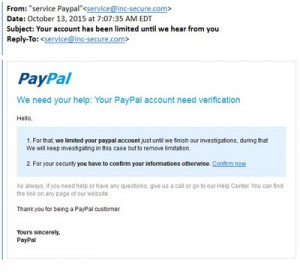 The definition is in the name, these are people “fishing” for your information. These types of scams exploit existing companies that you may or may not interact with. Using a popular companies name can make you believe the email is real.
The definition is in the name, these are people “fishing” for your information. These types of scams exploit existing companies that you may or may not interact with. Using a popular companies name can make you believe the email is real.
Account or Credit Information
Subject Lines: Your account is going to expire!, You’re Pre-Approved, or Guaranteed credit card
Scam: This will most likely contain a link that downloads malware, more specifically a keystroke logging malware so when it directs you to the convincing but fake website it steals your sensitive information.
Trojan Horse
These are emails that contain attachments. They usually promise something funny, a photograph, or a patch for software vulnerability.
Subject Line: Funny, Hi Friend, Check it out!
Scam: These attachments contain malware making your device vulnerable and possible installs software stealing your information.
Requests for Help
Disaster Relief
Fake charity websites are created to get people to donate money to a disaster such as 9-11 or Katrina.
Scam: Link inside email will direct you to offer your bank or credit card information to steal.
Nigerian – 419
These are very common scam emails that include sob stories, unfailingly polite language, and a promise of a big payoff.
Subject Lines: My Dearest Friend, Contact my secretary, and from the desk of.
Scam: Most offer huge payout if you help. Only problem is you need to pay a fee or “tax” to get the money. This allows scammer to take your money and identity.
Most Recent Reported Scams
 WhatsApp Scam Email
WhatsApp Scam Email
This email poses as a popular mobile phone app called “WhatsApp” claiming it has an incoming voice message for the user. Inside the email is a video message that if played will add malware to your device or bring you to a site that will add malware.
Credit Card Chip Scam Email
With new credit card chips on the rise, scammers have created an email that say you need to update your information to receive your new card. This is a method of phishing, and scammers even use the credit company’s logos. “… card companies won’t be giving you a heads-up, you’ll simply get your new card in the mail…”
How to recognize that an email is a scam?
- Sounds too good to be true
- Include words like easy, free, fast, and quick
- All capital letters
- Sounds urgent
- Uses misspelled words or slang
Sender
- Email account name does not match sender name.
 Example:
Example:
From: Meijer (ShopForMore@mymeijer.com) – The name of sender and email account match well enough to show some trust from the sender
Example:
From: Allied & NAVL (79JN@kipwring.com) – Most businesses have their business name after @ and before .com and start with either info, support, and noreply.
Body of Email
- Information is extremely vague – Especially when pertaining to subject lines about account expiration or upgrade, is a tactic to get you to click on link because of your confusion. This is also common in the ‘get rich quick scams’ and ‘lose weight fast’ using you curiosity to their advantage.
- Image is only thing in body – A real email will try to use a good mix of images and text.
- Plain text is only thing in body – Once again a real email will try to use a good mix of images and text.
How to avoid these scam emails?
 Install/Update Antivirus Software – This will help block any email-born viruses
Install/Update Antivirus Software – This will help block any email-born viruses
- Android Antivirus Apps
- iOS Antivirus Apps
- Desktop Antivirus
Install/Update Personal Firewall – This will also help block any email-born viruses
Setup Email Spam Filtering – A lot of emails offer spam filtering which does a fairly good job. This is not 100% effective though so do not rely on spam filtering.
 Setup Email Security – A lot of emails automatically have a security set up for spam but some you may need to configure yourself. Anytime you make an account on the internet you need to always check the security and privacy options to protect yourself.
Setup Email Security – A lot of emails automatically have a security set up for spam but some you may need to configure yourself. Anytime you make an account on the internet you need to always check the security and privacy options to protect yourself.
Do Not Trust Unsoliciated Email – These are individuals or organizations that are unknown. Most likely they are not a trustworthy sender.
Tip: Anything of real importance will contact you by phone or mail. Anything federal/Government related will only contact you by mail.
Be Cautious About Attachments – This is a very easy way to download malware onto your device. To be safe, only open attachments from trusted senders.
 Do Not Click Links – This is another easy way to download malware onto your device. Even though the link name may look familiar, mimicking a real business, it does not mean it is real.
Do Not Click Links – This is another easy way to download malware onto your device. Even though the link name may look familiar, mimicking a real business, it does not mean it is real.
Click link to see an example: https://www.youtube.com – Looks like a real link to YouTube but it didn’t take you to YouTube
Tip: Not sure if a link is safe? Type it into your browser instead of clicking on the link.
If you have been a victim of fraud email
- Run a antivirus scan
- Contact Credit Agency – You can place an alert with any one of the three major credit bureaus signals to potential creditors that you could be a victim of identity theft.
- Update Account Logons – Change passwords on as many accounts as possible
- Report it to Action Fraud
- Fill a complaint at the Federal Bureau of Investigation Internet Crime Complaint Center and review recent press releases
- File a report with the Federal Trade Commission
[stylebox color=”gray” bgcolor=”#7ad0ff” textcolor=”#000000″]
TIPS:
- IRS and court appearances will never contact you by email. They will most likely use paper mail.
- Type links into your browser instead of clicking on the link. This will prevent a redirected link.
- Do not open attachments unless from a trusted sender.
- If it is free or too good to be true then do not trust it.
- Before you donate to charity, research the company to make sure it is real. Use the Guidestar Nonprofit Directory to search for registered charities.
- Do not send money to people you do not know.
- If the subject line says urgent it’s most likely a scam.
- If buying any items, use scamAdviser to check website trust ratings.
[/stylebox]
Google Event. The Good and The Bad.
Google held their press event on Tuesday, September 19th in San Francisco announcing many new products such as the Nexus 6P and 5X, the new Chromecast 2, Chromecast Audio, and the Pixel C. They also announced their new Operating System.
 Nexus 6P
Nexus 6P
This was the most anticipated product coming out of Google and is considered the “flagship”. While there are a lot of great features in this new phone some have found minor complaints about the Nexus 6P
5.7 Inches
1440 Resolution
Metal Exterior
Gorilla Glass 4
7.3mm Thick
Snapdragon 810 Processor
Complaint: Users disappointed in this version of Snapdragon
Android 6.0 Marshmallow Operating System
3GB RAM
Complaint: Future is looking at 4GB and some worry this will not be enough RAM
Project Fi (WIFI) Availability
Updated Camera – 8 Megapixel front-facing and 12.3 Megapixel Back facing (4K video and slow-motion shots)
Complaint: There is a camera bump (similar to the iPhone bump) and an “ugly” black bar
Complaint: Does not have optical image stabilization (OIS)
2 Front Facing Speakers
Nexus Imprint – Fingerprint sensor. Used to easily unlock phone and can be used to authorize payments on android pay or the play store.
Larger Battery
USB Type-C port charging – “can charge the device twice as quickly as an iPhone 6 Plus” – The Verge
Complaint: Need to buy new cord.
Complaint: Future is leaning towards the wireless charging. Users disappointed that was not incorporated.
Colors – Frost White, Aluminum, and graphite
Cost – $499
 Nexus 5X
Nexus 5X
The Nexus 5X is considered the affordable alternative to the Nexus 6P over $100 cheaper. Even that being said it still has a lot of great features but the biggest worry it is not worth the update from their current phone. (ibtimes)
5.2 Inches
1080 Resolution
Gorilla Glass 3
Equipped with Android Marshmallow
Project Fi (Wireless Network) availability
Bigger battery
Nexus Imprint – Fingerprint sensor. Used to easily unlock phone and can be used to authorize payments on android pay or the play store.
USB Type-C port charging – “can charge the device twice as quickly as an iPhone 6 Plus” – The Verge
Complaint: Need to buy new cord.
Complaint: Future is leaning towards the wireless charging. Users disappointed that was not incorporated.
Snapdragon 808 processor – Many like this processor better than Nexus 6P’s Snapdragon 810
12-megapixel camera (4k video)
Cost – $379
Chromecast 2
Chromecast has gotten some updates but luckily the price did not change. A new look along with better Wifi are only a few update. Some features are still yet to come in the next year.
Wifi Updates – Supports 5GHz Wi-Fi and has 2 antennas for better streaming
New Look – A small disc with bendable HDMI arm
Colors – red, yellow, and black
Cost – $35 (no change)
 Chromecast App Update – Universal voice search tool – “fast Play” videos google thinks you want to watch – “what’s On” popular content (youtube and Netflix) – adding new apps, showtime, sling TV, NBA, and NHL and Spotify
Chromecast App Update – Universal voice search tool – “fast Play” videos google thinks you want to watch – “what’s On” popular content (youtube and Netflix) – adding new apps, showtime, sling TV, NBA, and NHL and Spotify
Only Complaint: Does not support 4k TVs
Chromecast Audio
Google announced a brand new product called Chromecast Audio. A neat way to put life back into your old speakers. You can connect and send music. Many were happy to here Chromecast now supports Spotify. With it’s cute look it seems to be a hit.
Plugs Into Speaker – 3.5mm audio port
OS Support – iOS/Android/Chrome
Supports RCA or optical outputs
Connect and Send Music – Using google play, Pandora, NPR one, Rdio, and Spotify (controlled by phone lock screen and android smartwatch or android and chrome tab)
Cool Look -Looks like a mini vinyl record
Cost – $35
Complaint: Users are concerned with compatibility with speakers.
 Pixel C
Pixel C
Top feature of the tablet Pixel C is that fact it is light but solid. The keyboard connects well and feels stable. While there is not a release date Google promises it will be out by the holidays.
10.2 Inch Tablet
Detachable Keyboard
USB Type-C port charging – “can charge the device twice as quickly as an iPhone 6 Plus” – The Verge
Complaint: Need to buy new cord.
Nvidia X1 Processor
Complaint: Users likes Intel Processor and not sure why they switched.
3GB of RAM
Android Marshmallow
Complaint: Users want the Chrome OS. Using a mobile OS limits some of the things that can be done on the tablet.
Cost – $499
Keyboard cost – $149
Complaint: Enter and delete key take time to getting used to placement.
Complaint: No touch pad. Sometimes the touchscreen is not optimal e.i. word documents.
 Android 6.0 Marshmallow
Android 6.0 Marshmallow
Android’s new ‘M’ operating system is the 6.0 Marshmallow. It comes with some desirable improvements.
Notifications – More consistent
Improves Battery Life
Fine-Grained Privacy Controls
Now on Tap – Google searches and voice interaction in individual apps
Doze – Power-saving mode – shuts down processes when hasn’t been moving or used
Not released to enough phones to have any known complaints
Devices to get Android Marshmallow:
End of 2015 – HTC One M9, One M8
Early 2016 – HTC M9+, HTC E9, HTCME, HTC E8, HTC M8 EYE, HTC Butterfly 3, HTC Desire 826, HTC Desire 820, HTC Desire 815
Samsung has yet to say except their new devices will not be launching with it. – techRepublic
Protect Your Smartphone From Malware
With the recent scares about Android’s ‘StageFright 2.0’ bug, that you get by opening a MP3 or MP4 file, it might get your wondering more about whether you have or had a bug on your phone. Different malware includes adware, bug, spyware, Trojan horse, virus, and many more (Learn more about Malware types ) There are some signs that your phone is being attacked and many ways to prevent your smartphone from getting malware. Already have a virus? There are ways to get your phone back in your control.
Has your phone been bugged? Here are some signs your phone is being tapped into:
- Difficulty Shutting Down – You may experience a delay in shutting down your phone. Often you will notice the back-light is still on even after it’s shut off.
- Odd Activity – This can consist of distortions on your screen or even application being installed by itself.
 Call Interference – During phone calls there may be unexplained background noises, clicks, echoes, or static.
Call Interference – During phone calls there may be unexplained background noises, clicks, echoes, or static.- Data Use Increase – Drastic increases in data without a good explanation. Not sure how to tell… “Look at how much data your device is using, and see if there’s a big discrepancy between how much data you’re using, and how much your applications are using. Any difference involving 10MB or more might be a sign of ‘parasitic activity’” – DarkReading
- Low Battery and High Temperatures – Both paired together could be caused by a constantly running application tapping into your phone.
- Coded Text Messages – This is a strong sign your phone has been tapped
The 2015 Internet Security Threat Report from Symantec showed that data breaches surged by 23 percent last year, and nearly a million new pieces of malware (“malicious software”) were created per day. Almost 1 in 5 Android apps available last year were actually malware in disguise, says the same report. The more popular smartphones and downloading apps become, the more popular malware and other viruses are becoming as well. Be smart and keep your smartphone safe from these bugs.
How do you prevent your phone from getting infected?
Strong Lockscreens – The stronger your passcode to get your phone unlocked the more secure your phone is.
- Not sure how to set up a lockscreen…

- Android Lockscreen Setup
- iPhone Lockscreen Setup
- Top lockscreen apps…
Get A Security Program – Ultimately the best ones would include anti-virus, anti-malware, anti-spam, anti-phishing defense, and a firewall.
- Android Antivirus Apps
- iOS Antivirus Apps
Update Your OS – There is a reason they come out with updates and new operating systems. The longer you put off updating your phone, the more susceptible it is.
Use Trustworthy Companies – If you are downloading applications, ringtones, wallpapers, etc. always use trustworthy companies, take the time to read reviews too.
Avoid Suspicious Websites – If you feel suspicious there’s good reason.
- How do you tell a website is unsafe? (SpyRambly)
- Poor layout
- Bright and flashing buttons, banners, or images
- Constant pressure to download
- Manipulation used to click on unsafe links
Turn Off Bluetooth – When you are not using the Bluetooth, have it set to off
Take Out Battery – Although this make not as practical for frequent users but if you know you won’t be using your phone for a while, take out the battery.
Don’t Jailbreak – If you jailbreak your phone this leaves you much more susceptible to viruses.
Use the Two Step Verification – This is an extra security step.
- Not sure how to set it up…
- Google 2-Step Verification
- Apple 2-Step Verification
Encrypt Sensitive Information – Another extra security step to help keep you safe.
- How do you encrypt?
 TIP: Backup Your Information – No matter how hard you try to prevent it there is still a chance you will get infected. It is always a good idea to have your information backed up in case you have to wipe your phone clean.
TIP: Backup Your Information – No matter how hard you try to prevent it there is still a chance you will get infected. It is always a good idea to have your information backed up in case you have to wipe your phone clean.
- How do you backup your phone?
- Android Backups
- iPhone Backups
My phone is infected! What do I do now?
- Take out your SIM card at first sign of malware
- Restart your phone in ‘Safe Mode’
 Depending on the severity of the infection:
Depending on the severity of the infection:
- Uninstall the application or remove file/software from where the malware came from
- Reset to factory settings – you can do this on your own or take it to your provider (This is where backing your information up is important)
- Run an anti-virus scan
Children Around the World Learning Code
Children Around the World Learning Code
What does it have to offer:
“It’s no longer just ‘learn to code’… [it’s] a ‘code to learn’ philosophy.” Learning to code offers more than just that, it teaches other outside of coding that relates to other school subjects and generally life skills. Tynker has a great table of the core classes they teach with their courses for each grade-level.
Code uses nouns, verbs, adjectives, adverbs, preposition, phrase patterns, conjunctions, conditionals, clauses, algorithms, and other math operations.
Skills:
- STEM
- Grammar
- Pattern recognition
- Math
- Computational thinking
- Logical thought
- Critical thinking
- Design thinking
- Key technology
Not only does learning code teach a lot of skills but also gives children great career prospects.
Countries teaching children to code:
Hour of Code is a global movement to teach kids and adults to code. These events are being offered in 180+ countries. Code.org
Africa Code Week: 17 African countries celebrate Africa Code Week aiming to teach 15,000 children to code. A variety of programs such as Scratch, Teens Get Coding, and Teaching programming to Young Learners are being used to teach code to a range of ages. Many coding activities will be offered from October 1 through 10, 2015.
17 African countries celebrate Africa Code Week aiming to teach 15,000 children to code. A variety of programs such as Scratch, Teens Get Coding, and Teaching programming to Young Learners are being used to teach code to a range of ages. Many coding activities will be offered from October 1 through 10, 2015.
UK Computing Curriculum:  UK has made coding a part of the core curriculum in September 2014. There are five learning basic principles ‘what is an algorithm?’, ‘the importance of logic and data representation’, and ‘how to recognize common uses of programming beyond school.’ In UK a survey showed that 6 out of 10 parents would rather have their kids learn a computer language rather than French.
UK has made coding a part of the core curriculum in September 2014. There are five learning basic principles ‘what is an algorithm?’, ‘the importance of logic and data representation’, and ‘how to recognize common uses of programming beyond school.’ In UK a survey showed that 6 out of 10 parents would rather have their kids learn a computer language rather than French.
Australia Technology Change:  Australia’s new Prime Minister, Malcolm Turnbull, has announced what he calls a “21st-century government”. Code.org has 148 “Hour of Code” events which is helping with Turnbull’s idea of keeping Australia up with the technological world.
Australia’s new Prime Minister, Malcolm Turnbull, has announced what he calls a “21st-century government”. Code.org has 148 “Hour of Code” events which is helping with Turnbull’s idea of keeping Australia up with the technological world.
Many more countries are introducing children (and adults) to coding with either the “Hour of Code” events or introducing it to schools.
- Scratch – free, Age 8 – 16, multi-lingual
- ScratchJr – free, Ages 5 – 7, mulit-lingual
- Teens get Coding
- Tynker – free to $2000, Ages 7 – 12+
- The Foos – Ages 5+
- Kodable – Free trial and $ for more
- Code Club – UK Extra Curricular, Ages 9 – 11
Global Movement:
- Hour of Code – 180+ events, All Ages
- CoderDojo – UK Extra Curricular, Ages 7 – 17
Why Your Website Should Keep Up With The Joneses
Imagine that your company has worked through all of the items on your SEO checklist, but you still aren’t making it to the top of the Search Engine Results? What’s a dot com to do?
Your website needs to keep up with the Joneses for SEO and SEM
Keeping up with the Joneses refers to the comparison to one’s neighbor as a benchmark for social class, your website needs to do the same, it needs to keep up with your neighbors search engine optimization (SEO) and search engine marketing (SEM) efforts. By spending time researching your competitors you can learn a lot about what works and what doesn’t drive traffic.
According to Website Magazine, you should “learn from your competitors, identify your strengths and their weaknesses, and improve upon what they are doing. If you beat them in the majority of small battles, you are bound to win the war.” Conducting competitive research is neither unethical or illegal.
Be a nosy neighbor
There are a few different ways to check out your competitor’s online efforts. Among the easiest, of course, is to look them up and check out their website. Take a look at what pages and types of information they have on their website. Do they have a blog or case studies? If they have a blog, what are they writing about? If you have a different take on things or have the experience to write helpful articles for your clients too, then it may be time to add a blog section to your website. There are great tools out there to take a look at your competitors SEO rankings, such as Moz.
You can also google some of your industry keywords and see if your competitors come up with ad listings or in the organize search results. Your competitors ranking for keywords will help you build a link building roadmap. Don’t forget to study your competitor’s landing page, what key points are they making to complete the sales conversion? Tools like SEMrush provide insights to how your competitors are using search engine marketing, aka pay-per-click ads.
Maintained grass is always greener
Backlinks are a low hanging fruit that is a key aspect of gaining search engine ranking. The term “backlinks” refers to links back to your website from other websites, such as press releases or blog mentions. Analyzing your competitors’ backlinks can reveal easy opportunities for backlinks you can quickly recreate to point to your own site. Anchor links may not have a huge impact on search engines at this time. However, they can easily be viewed allowing you to see what keywords your competitors are putting their time and effort into.
Knowing your competition
Charting and knowing what works for your competitors will allow you to be more focused when making marketing decisions. If a competitor is dumping a lot of money into a keyword, don’t try to outbid them. Instead, choose another area of the market to focus on. The same thing applies to SEO – instead of chasing your competition, focus on an area of the market that they are not currently leveraging.
Sources:
Website Magazine: http://www.websitemagazine.com/content/blogs/posts/archive/2015/08/18/23-mistakes-that-kill-search-traffic-and-conversions.aspx
Website Magazine:
http://www.websitemagazine.com/content/blogs/posts/archive/2014/07/11/weekend-warrior-spy-on-the-competition.aspx
How to Choose a Good Domain Name (and Keep It)
The first topic we cover with our new clients is usually “How to Choose a Good Domain Name”. We’ve been helping businesses and organizations with websites for over 15 years, there is strategy and logic that comes into play when choosing a domain name and keeping it.
Domain Name Choices
It’s not a bad thing to have more than one domain name that leads to your website, however, you will want to choose one main domain name to use the majority of the time. Start by brainstorming keywords that describe what type of service or organization you are. If your business already has keywords in its name consider using it for your website. But remember, you’re going to want to keep your domain name short, easy to type and easy to remember.
What Domain Extension Should I Purchase?
More and more domain extensions have come on the market, .com and .net aren’t your only options anymore. There is everything from .photography to .tv available for purchase now. These extensions have their benefits, for example, we use http://unionmade.website to promote our union website services because it’s obvious that URL will lead a union website company. It’s recommended to use a .com address as your main domain as this is the most common domain extension and Apple devices even have a .com key on their keyboards.
With all of the domain options out there costing between $12 and $20 a year don’t be afraid to purchase a couple of them and monitor your website statistics to see which ones are being used and how users are getting to them. We also recommend using a separate domain name for your company’s email addresses to cut down on spam. For more information about choosing a domain name check out this article from Moz.com.
Keeping Your Domain Name Safe
You’ve picked the right domain name, you’ve shared it with everyone and even have it etched on your building, but then one day you go to open your website and it’s not there. What happened? You’ve forgotten to renew your domain name at the registrar.
Getting Your Domain Name Back
If you’re lucky when your domain expired a contact called and said their email bounced back when they tried to contact you. So you forwarded their message to your website developer and they reminded you to go renew your domain name ASAP. In this case the domain name was not out of the 30 day redemption window yet, so you can pay an $80-$200 fee and get your domain back out of expiration status. Whew, close one.
On the not so lucky side, you didn’t notice emails bouncing and didn’t notice your website wasn’t up at your domain URL. It’s been over 30 days since it expired and someone else purchased your domain name. This is legal and one of three things can now happen.
- You contact the new owner and they tell you that the domain can be purchased from them for ANY amount they name. We’ve seen this number in thousands before. Ouch.
- You contact the new owner and they say they’re happy with the new domain name and they are keeping it, it’s not for sale back.
- You don’t see a new website at your domain, just a registrar’s page. You can initiate a domain backorder on the domain name and after a year if the new owner doesn’t renew the domain name and you win it back into your hands. But for a year you have neither a website nor email, not really an option.
All of these options carry at least an $80 fee, that’s a big deal when you only spent $20 a year on the domain name. If you’re not willing to pay the domain ransom you’re going to buy a new domain name
Steps for Moving to a New Domain Name
- Buy a new domain name.
- Point your website hosting to the new domain name. You did renew your website hosting right? If not contact the web host, if you’re lucky they still have your files around and you can renew services with them. If they don’t have your files then you’ll be creating a new website unless your web developer backed up your website files and can restore them for you.
- Create new email accounts at the new domain name and notify all contacts of your new email address. All emails sent to your old email address can now be received by the new domain owner if they setup a catch all on the domain’s email.
- Update signs, vehicles, stationary, etc. This is where things get expensive and you may rethink paying the domain ransom.
How to Avoid Losing Your Domain Name
We recommend buying your domain name for 10 years at a time, that’s about $200 total for peace of mind, it pays for itself considering the expiration redemption fee is $80-$200. Put sticky note under the calendar on the wall with the domain expiration date on it so every year you see it and know when the date is coming up. At that time go into your registrar account, update your credit card and renew for another 10 years.
You can also leave your domain name in the hands of a website host or a website development company, but again if credit cards aren’t renewed or bills aren’t paid you could have your domain name lost or held for ransom. We’ve had clients come to us with stories of their previous web development company closing and disappearing, taking their files and domain names with them.
Our policy at Appletree MediaWorks is to have our clients keep their domain names in their own personal registrar accounts and we keep a list of their expiration dates in office so when an expiration date is approaching we can remind clients to renew their domain names.














